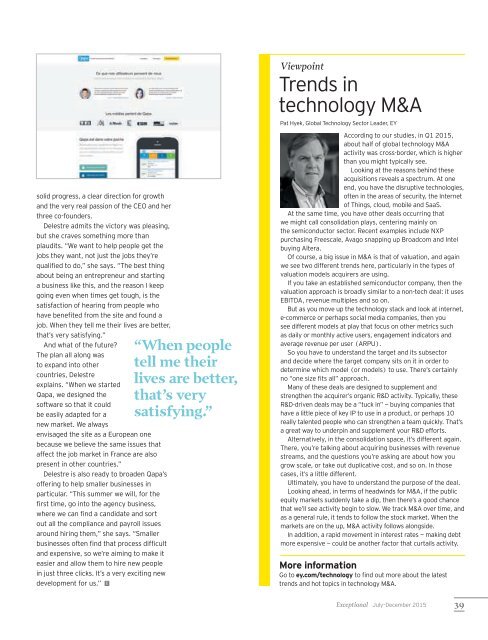Exceptional
Ua1bc
Ua1bc
You also want an ePaper? Increase the reach of your titles
YUMPU automatically turns print PDFs into web optimized ePapers that Google loves.
solid progress, a clear direction for growth<br />
and the very real passion of the CEO and her<br />
three co-founders.<br />
Delestre admits the victory was pleasing,<br />
but she craves something more than<br />
plaudits. “We want to help people get the<br />
jobs they want, not just the jobs they’re<br />
qualified to do,” she says. “The best thing<br />
about being an entrepreneur and starting<br />
a business like this, and the reason I keep<br />
going even when times get tough, is the<br />
satisfaction of hearing from people who<br />
have benefited from the site and found a<br />
job. When they tell me their lives are better,<br />
that’s very satisfying.”<br />
And what of the future?<br />
The plan all along was<br />
to expand into other<br />
countries, Delestre<br />
explains. “When we started<br />
Qapa, we designed the<br />
software so that it could<br />
be easily adapted for a<br />
new market. We always<br />
envisaged the site as a European one<br />
because we believe the same issues that<br />
affect the job market in France are also<br />
present in other countries.”<br />
Delestre is also ready to broaden Qapa’s<br />
offering to help smaller businesses in<br />
particular. “This summer we will, for the<br />
first time, go into the agency business,<br />
where we can find a candidate and sort<br />
out all the compliance and payroll issues<br />
around hiring them,” she says. “Smaller<br />
businesses often find that process difficult<br />
and expensive, so we’re aiming to make it<br />
easier and allow them to hire new people<br />
in just three clicks. It’s a very exciting new<br />
development for us.”<br />
“When people<br />
tell me their<br />
lives are better,<br />
that’s very<br />
satisfying.”<br />
Viewpoint<br />
Trends in<br />
technology M&A<br />
Pat Hyek, Global Technology Sector Leader, EY<br />
According to our studies, in Q1 2015,<br />
about half of global technology M&A<br />
activity was cross-border, which is higher<br />
than you might typically see.<br />
Looking at the reasons behind these<br />
acquisitions reveals a spectrum. At one<br />
end, you have the disruptive technologies,<br />
often in the areas of security, the Internet<br />
of Things, cloud, mobile and SaaS.<br />
At the same time, you have other deals occurring that<br />
we might call consolidation plays, centering mainly on<br />
the semiconductor sector. Recent examples include NXP<br />
purchasing Freescale, Avago snapping up Broadcom and Intel<br />
buying Altera.<br />
Of course, a big issue in M&A is that of valuation, and again<br />
we see two different trends here, particularly in the types of<br />
valuation models acquirers are using.<br />
If you take an established semiconductor company, then the<br />
valuation approach is broadly similar to a non-tech deal: it uses<br />
EBITDA, revenue multiples and so on.<br />
But as you move up the technology stack and look at internet,<br />
e-commerce or perhaps social media companies, then you<br />
see different models at play that focus on other metrics such<br />
as daily or monthly active users, engagement indicators and<br />
average revenue per user (ARPU).<br />
So you have to understand the target and its subsector<br />
and decide where the target company sits on it in order to<br />
determine which model (or models) to use. There’s certainly<br />
no “one size fits all” approach.<br />
Many of these deals are designed to supplement and<br />
strengthen the acquirer’s organic R&D activity. Typically, these<br />
R&D-driven deals may be a “tuck in” — buying companies that<br />
have a little piece of key IP to use in a product, or perhaps 10<br />
really talented people who can strengthen a team quickly. That’s<br />
a great way to underpin and supplement your R&D efforts.<br />
Alternatively, in the consolidation space, it’s different again.<br />
There, you’re talking about acquiring businesses with revenue<br />
streams, and the questions you’re asking are about how you<br />
grow scale, or take out duplicative cost, and so on. In those<br />
cases, it’s a little different.<br />
Ultimately, you have to understand the purpose of the deal.<br />
Looking ahead, in terms of headwinds for M&A, if the public<br />
equity markets suddenly take a dip, then there’s a good chance<br />
that we’ll see activity begin to slow. We track M&A over time, and<br />
as a general rule, it tends to follow the stock market. When the<br />
markets are on the up, M&A activity follows alongside.<br />
In addition, a rapid movement in interest rates — making debt<br />
more expensive — could be another factor that curtails activity.<br />
More information<br />
Go to ey.com/technology to find out more about the latest<br />
trends and hot topics in technology M&A.<br />
<strong>Exceptional</strong> July–December 2015<br />
39









